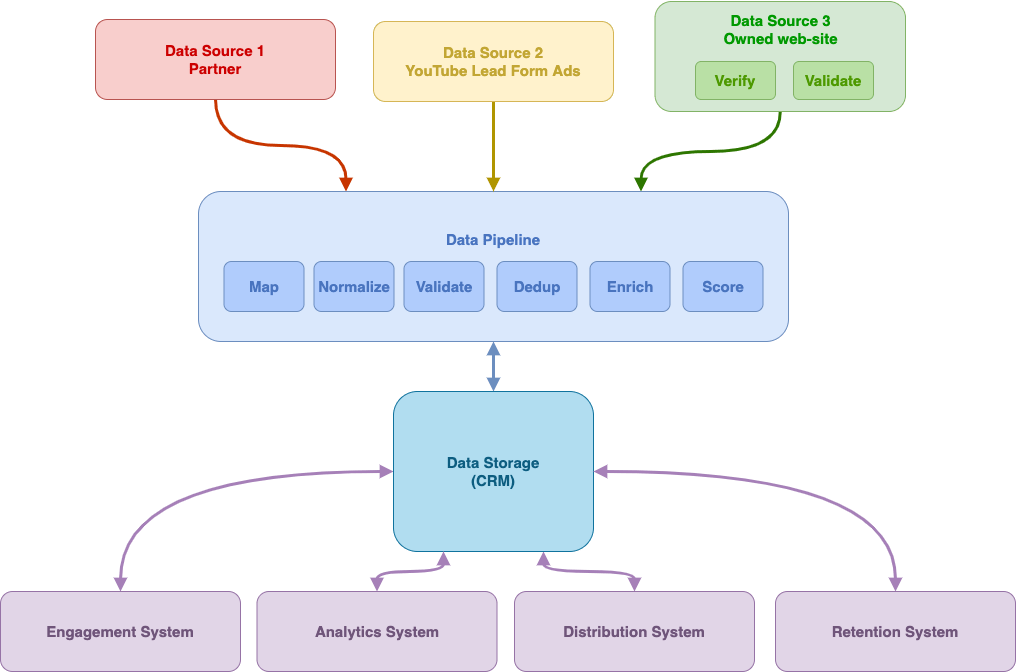Lead Lifecycle
Lead generation is a complicated business, but operational work could be significantly improved with the usage of the right technical tools. In this article let’s discuss how to build a reliable and scalable Lead pipeline.

Sources
The Lead lifecycle starts with sources
Some sources are reliable – for example, your own website with a captcha, or custom code for capturing the digital footprint of the user for further verification that the form was filled by a real person and verification of entered data.
Right on the form, you can verify a number of parameters, starting from basic email format, and then adding more complex verification like:
– ZIP match the city
– Correctness of phone and email format
– The address is existing (using google API, for example)
– Education level measures up to the age
Some sources are less reliable, like social networks, third-party sites, phone centers.
Try to minimize the risk by adding custom JS or third-party services (serviceobjects, jornaya, etc.) for leads verification from third-party sites.
Others may be pretty bad – like third-party feeds, purchased leads.
Pipeline
Data mapping and normalization
Once a lead is captured, before processing to the next step make sure that you use the same terminology for all leads. Are you using DOB or Age? Are you using Zip or Postal code, are you using First Name, Last Name, or Given Name, Family Name?
After this make sure that all parameters are normalized. For example, systems always use the same values male/female/unknown for gender, and not different values from different sources, like m/f/null, or 1/2/3, etc.
Remove scum and spam
Since not all sources are reliable it is important to validate that your data is real and correct in the processing pipeline. With the amount of scum on the internet, this step is crucial for further work with leads. It can do the same that was described for own-hosted site validation, but it could be much more robust (can not only validate the phone format but also verify that it is real l https://www.phonevalidator.com/phone-validator-api.aspx, can verify that user IP address is from the state specified in the form. The validation can be much more complex: use AI, your own DB of fake or valid values, industry-specific rules.
Matching and deduplication
Once we have a valid lead – it should be matched against existing records by key parameters (good parameters for matching rules are email, name+DOB, SSN). You can even use AI for matching predictions; you can use available services or your own software for this. When matched – some parameters might be updated, like address, education. Others should be added additionally, like email, phone.
Data enrichment
For new leads, it makes sense to extend and expand the information that you have for the lead. Data enrichment may be used for demographic data enrichment, geographic or professional data enrichment as well as behavior data enrichment. For this may be used one of the available services (Clearbit, InsideView, Enrich.io, Pipl, etc.), social networks may be used, though it becomes harder to use them over time, own database (DB of zips per city, DB of school degrees, DB of names to gender mappings, etc.) or available online information.
Scoring
Not all leads are equal, not all fit specific clients. Some are ready to buy right now; some will likely be ready soon, and some are just entering the funnel. There are many online services for lead scoring, but no one knows your business better than you. Set your metrics and score leads upon them. If you resell leads – make sure that the most valuable leads are sent to the right clients.
Data Storage
Store data on your storage and make sure it is accessible by Distribution, Engagement, Analytics, and Retention systems.
Protect the data
Do not forget about general data storage rules, this is even more important for working with real people’s data. Make sure that you have a backup and recovery system in place with properly protected backups storage. Apply security rules and proper access rights are applied and your data is protected and secured.
Data update and actualization
Lead lifecycle is not finished when a lead is converted or sent to the client. Using data over time is more important than storing it in the first place. Keep, update and reuse leads. Lead interests and information may be updated in an interactive way using emails, call centers, targeted ads, and promotions. Or it could be automated using social media and known activities (like usage of your or your client’s services).
Lead retargeting
Lead retargeting is a key to success. People are used to using multiple services and products at the same time, but also they use specific services in a logical sequence. For example, lead for education will become a great lead for hiring companies. Use leads smart, keep their history, and predict future interests.
Analytics
Your pipeline should not lose any data. Keep track of everything that is going on with the lead and use the Data wisely. Right analytics would help to:
– Get insights into what sources perform better
– Understand where fake data is coming from
– Understand the sources of the most valuable data and the best leads
– Track and predict campaigns performance and ROI
– Improve your validation and scoring over time
Lead retention
Though retargeting is great for the business, respectful and lawful communication with people is even more crucial. Provide a way to unsubscribe from automated marketing emails. With GDPR and CCPA in place make sure that your leads data is managed properly and could be deleted by a person’s request.